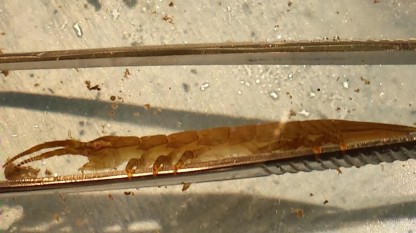While browsing the Beachcomber’s Guide to Seashore Life of California, I came across a curious fact about isopods, little dorsoventrally flattened crustaceans commonly seen scurrying about in the intertidal algae. One of them, the Western Sea Roach (Ligia occidentalis), was said to shift its color daily, darkening as the sun came up. (Sept 2009) This got me wondering how isopods can change their colors when so firmly locked within a chitinous exoskeleton.
I was inspired to learn more when a beautiful “eelgrass isopod” (Idotea resecata) showed up in lab. It was translucent, nearly transparent, with a persistent and mesmerizing flicker of its tail fins (uropods) visible beneath its concave tail (telson).
Fig 1. Idotea resecata, in its kelp-colored morph. Note the concave tail that distinguishes it from close relatives.
A search of the literature quickly showed that isopods vary tremendously in their color changing abilities. Pelagic Idotea metallica lives among floating mats of algae, and can use little pigment sacks called chromatophores to change colors on the fly (or on the drift, as it were). In contrast, its close relative, Idotea montereyensis, doesn’t use its chromatophores to change color. The explanation for the difference may lie in the fact that this species relocates seasonally and therefore needn’t be as plastic, only altering colors significantly when it molts. (Lee and Gilchrist 1972).
Fig 2. With no kelp to be found in lab, Idotea resecta clings tenaciously to my probe.
So what of our lab visitor, Idotea resecata? It neither migrates nor drifts among the plankton. Judging by the way it clung to my probe in lab, I would decidedly describe it as a home body! So, perhaps it’s not surprising that the poor eelgrass isopod has no ability what-so-ever to change its color! (Lee and Gilchrist 1972). With nearly a dozen types of pigments layered into different strata of the cuticle, it has already fine-tuned its color to be a nearly perfect match of its background. It comes in either a brownish-green variety to match kelp (Macrocystis spp.), as seen above, or a grass-green variety to match eelgrass (Zostera marina). Such polymorphism based on vegetation type has been shown to have a genetic basis in other isopods. (Anders et al. 2004) In other words, when color morphs are stable, as they are in the eelgrass isopod, this is an evolved adaptation rather merely than an acclimatization.
Fig 3. Idotea wosnesenskii (left, with convex telson) blends well with a common brown algae, Laminaria sp. (right). (left photo: JMax and right photo: Chris Booth)
It had long been suspected that such colors represented a beautiful example of camouflage, but that assertion was recently bolstered when predation experiments were performed using a common relative, Idotea wosnesenskii, seen below. When researchers placed I. wosnesenskii on color-matched vegetation, the isopods had a survival advantage against visual predators, especially fish. (Hultgren and Mittelstaedt 2015) Curiously, the type of algae they were fed did not affect their color. Rather, it seemed they were continually able to match the substrate algae in spite of an alternate food source. The isopod’s color was not from a simple sequestering of dietary pigments but rather from a more complex metabolism of those pigments, a reshaping of the food molecules into the isopod’s own unique color-mimicking recipe (Hultgren and Mittelstaedt 2015). Perhaps simple camouflage is not so simple after all.
References:
Hargeby A, Johansson J, Ahnesij J, & Merila J (2004) Habitat-Specific Pigmentation In A Freshwater Isopod: Adaptive Evolution Over A Small Spatiotemporal Scale. Evolution 58.1: 81-94.
Hultgren KM & Mittelstaedt H (2015) Color Change In A Marine Isopod Is Adaptive In Reducing Predation. Current Zoology 61.4: 739-748.
Lee W (1972) Pigmentation, Color Change and the Ecology of the Marine Isopod Idotea resecata. Journal of Experimental Marine Biology and Ecology 10.1: 1-27.
Sept, D (2009) Arthropods p. 167. Beachcomber’s Guide to Seashore Life of California. Harbour Publishing, Madeira Park, British Columbia.


